Gupta Architecture › Winning Against the Odds: Sargon II & the Urartu Campaign
Articles and Definitions › Contents
- Gupta Architecture › Ancient History
- Winning Against the Odds: Sargon II & the Urartu Campaign › Antique Origins
Ancient civilizations › Historical places, and their characters
Gupta Architecture › Ancient History
Definition and Origins
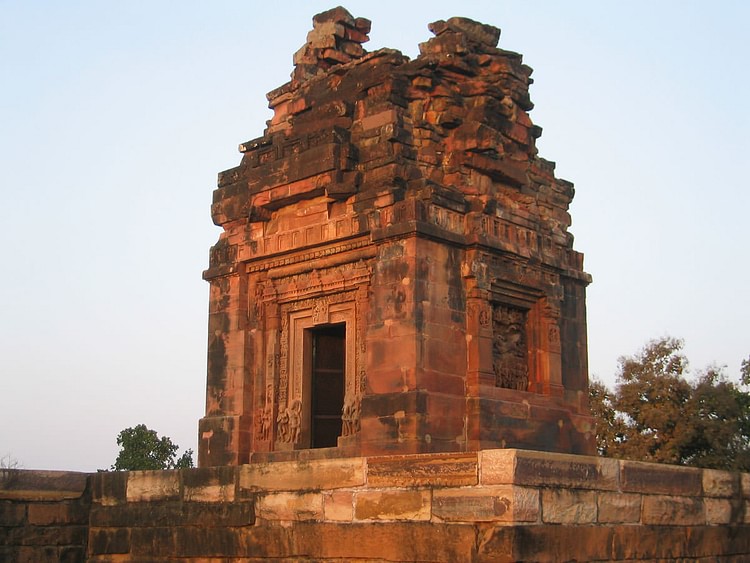
The Gupta Dynasty, founded by Chandragupta I (accession c. 320 CE), ruled in North Central India between the 4th and 6th centuries CE and the period is considered a golden age of artistic accomplishment. The Guptas were the first architects of purpose-built Hindu (but sometimes also Buddhist ) temples which evolved from the earlier tradition of rock-cut shrines.Adorned with towers and elaborate carvings, these temples were often dedicated to all the Hindu gods. Unfortunately, relatively few of the large number of Gupta temples built have survived.
Gupta architecture is very diverse in style, design and features. This very diversity illustrates that Hindu temple architecture was in its formative stage and was yet to arrrive at the standardised situation of later centuries. Nevertheless, the influence of Gupta-era buildings on later Indian temple architecture is indisputable and continued right through to the Medieval period.
GUPTA CAVE SHRINES
The earliest examples of religious architecture were cave-temples which typically had exteriors decorated with relief sculpture and a single carved doorway. Inside the shrine, ritual sculptures were placed such as a Shiva linga (phallus) and the walls were richly decorated with more carvings showing scenes from mythology. Notable examples are found at Udayagiri in Madhya Pradesh where one cave bears a date mark of 401 CE. Here in one shrine is one of the finest examples of Gupta art, the celebrated relief showing Vishnu in his incarnation as the boar-headed Varaha. The panel measures 7 x 4 metres and the central figure, carved almost in the round, is emerging from the cosmic waters, having defeated a snake-like monster and rescued the goddess Bhudevi (Earth). The scene, a famous Hindu myth, may also be an allegorical reference to the peace and protection offered by the Gupta kings.
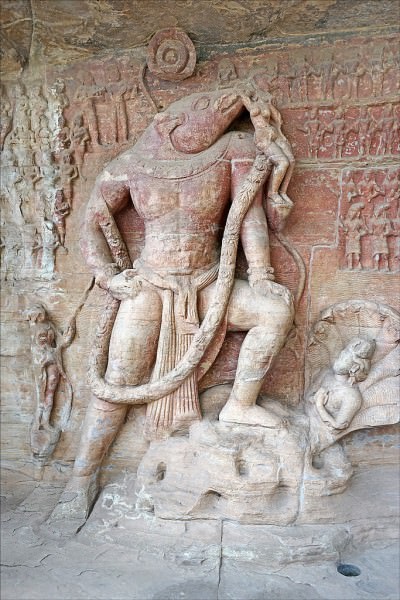
Vishnu as Varaha, Udayagiri Caves
Finally, mention should be made of the Ajanta caves, a row of 29 rock-cut caves following the Waghora river bed ravine in north-west Deccan. Dating from the 2nd century BCE to 7th century CE, they contain some of the earliest and finest examples of Indian wall -painting. The subject matter is largely scenes from the life of Buddha. Cave 1 contains a columned shrine in typical Gupta style with flat cushion-topped column capitals. Cave 19 was built in the 5th century CE and has a Gupta-style chaitya (shrine) facade with columned porch and large, almost semi-circular aperture above. The whole facade is covered in rich carvings and relief panels showing scenes from Buddhist lore.
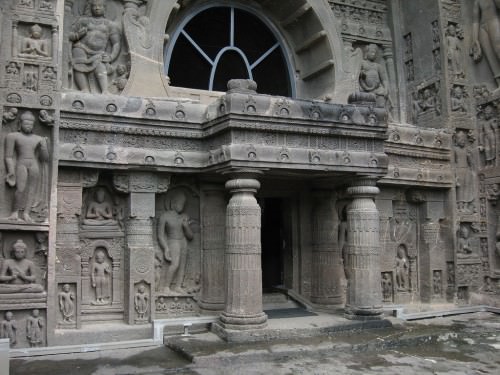
Cave 19, Ajanta, Deccan
GUPTA TEMPLES: MATERIALS & FEATURES
Not satisfied with caves the Guptas were the first dynasty to build permanent free-standing Hindu temples and so they began a long tradition of Indian temple architecture. It is perhaps important to note here that Hindu temples were not designed for congregations but rather as the dwelling place ( devalaya ) of a deity. This decorated palace ( prasada ) allowed priests to give offerings to the gods and individuals could also offer prayers, flowers, and food ( puja ), usually to a sacred relic or statue representing a particular god which was housed in a relatively small and windowless architectural space (the garbhagriha ).Believers would also walk around the temple in a ritual act of worship.
IN GUPTA ARCHITECTURE THE SQUARE WAS CONSIDERED THE MOST PERFECT FORM AND TEMPLES WERE DESIGNED TO BE APPRECIATED FROM ALL SIDES.
The Gupta style was influenced by Kusana, Mathura, and Gandhara and borrowed the common features of T-shaped doorways, decorated door jambs, sculpted panels with high-relief figures, and laurel-wreath and acanthus motifs. Constructed using sandstone, granite, and brick, Gupta-era temples added to this architectural heritage with horseshoe gavakshas arches and distinctive curved shikhara towers which are frequently topped with a ribbed disk ornamentation known as an amalaka.These elaborate buildings are further decorated with a mass of ornate mouldings and sculptures set in niches. In Gupta architecture, the square was considered the most perfect form and temples were designed to be appreciated from all sides so that each carries decorative architectural features.
Most temples also adopt a square plan with the single cubicle garbhagriha in the centre. This is normally entered by a short columned porch set over a single, highly decorated doorway with a projecting lintel. Columns can support a pot-and-foliage capital, and roofs were generally flat, as in surviving examples at Tigawa and Sanchi in Madhya Pradesh. Other typical Gupta decorative features include triangle motifs inside doorways and lion's heads at the ends of stone beams.
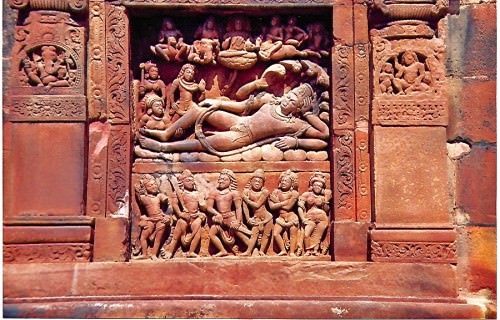
Vishnu Anantasayana Panel, Dashavatara Temple, Deogarh
Whether all temples had a second floor is difficult to determine, due to their often ruinous condition. The late 5th century CE Parvati temple at Nachna Kuthara is notable for its surviving second-story shrine room. From the 6th century CE, Gupta temples were built on a platform ( jagati ) and a good example is the Dashavatara temple at Deogarh in Madhya Pradesh. At Deogarh the platform had reliefs running around it depicting scenes from the Ramayana epic poem. In the centre of the jagatistood the principal shrine, which was without windows and accessed by a flight of steps on all four sides. Four lesser shrines stand at each corner of the complex.
Typical of the period in general, Gupta temples were dedicated to a large number of Hindu gods rather than a single deity.Accordingly, architectural sculpture represents a wide range of gods in scenes from Hindu mythology. The doorway to the square sanctuary tower of the Dashavatara temple is a fine example and carries sculpture of Vishnu, Brahma, Indra, Ganga, and Yamuna, as well as attendants and mithuna couples. The temple also carries one of the most famous sculptural panels from ancient India, the Vishnu Anantasayana panel. The scene contains many gods but is dominated by a sleeping Vishnu who rests on the multi-headed serpent Ananta and floats on the waters of oblivion whilst from his navel sprouts a lotus leaf on which sits Brahma, the god of creation.
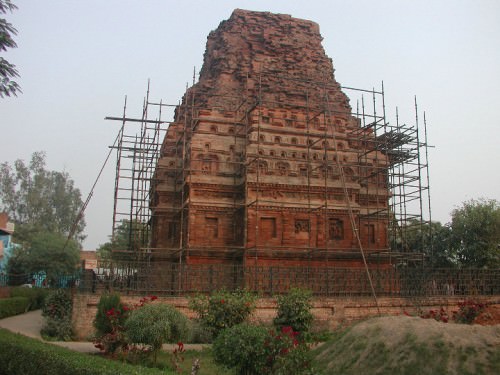
Bhitargaon
BHITARGAON
The temple at Bhitargaon in Uttar Pradesh is one of the most complete surviving Gupta temples. It is a rare early example of a Hindu temple constructed entirely of brick, dating to the late 5th century CE. Although damaged in its upper portion, the four-sided and curved shikhara tower of the temple maintains its gavaksha niches and shallow pilasters which diminish in size as the tower rises to a pinnacle. These and the decorated capitals create frames in which were once set terracotta panels.
Few panels survive intact but examples from other sites demonstrate that they would have once shown lively scenes from mythology, in particular figures of river goddesses. Panels still in their original position in the upper tiers of the tower display grotesque faces which remind of the gargoyles of European Gothic cathedrals (Harle, 115).
Winning Against the Odds: Sargon II & the Urartu Campaign › Antique Origins
Ancient Civilizations
It is often when one is faced with the most difficult circumstances that one is given the greatest opportunity for clarity. History provides ample evidence of this experience in showing how, when faced with seemingly impossible situations, people found a way to see beyond their situation and prevail against it.
These stories span centuries and civilizations but all have one thing in common: the heroic nature of the human spirit. Even in the midst of the most daunting circumstances, people can find a way to realize their objectives, sometimes against all odds, and emerge victorious.
One example of this is seen in the 714 BCE Assyrian campaign of Sargon II (reigned 722-705 BCE) against the kingdom of Urartu. While there are plenty of stories that epitomize perseverance and determination, this campaign exemplifies that virtue of the human spirit that helps one endure, and even triumph, when there seems little chance of success.
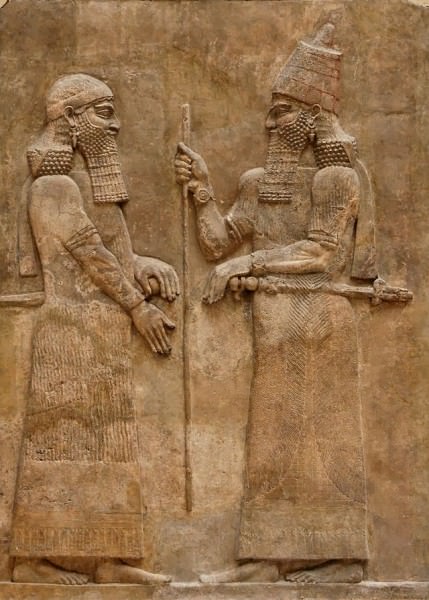
Sargon II
THE PROBLEM OF URARTU
Sargon II of Assyria inherited a serious problem when he came to the throne in 722 BCE: the neighboring kingdom of Urartu.Urartu lay in the foothills of the Taurus Mountains, only 30 miles (48 kilometres) from the Assyrian border, and had grown in power throughout the 13th to the 11th centuries BCE. The Temple of Haldi, in the holy city of Mushashir in Urartu, had been an important pilgrimage center since the 3rd millennium BCE, and the offerings from kings, princes, nobility, and merchants filled its treasury.
The Urartians had grown in wealth from trade and from caravans of pilgrims coming to visit Mushashir. To ensure continued prosperity, the Urartians continually tried to keep the lowlands around their kingdom under their control. From their fortress in the mountains, they continually raided and annexed territories in the lowlands. The Urartians were fierce warriors who bred some of the best horses in the region and raised them specifically for combat.
Shalmaneser I (1274-1245 BCE) first mentioned Urartu in Assyrian inscriptions in relating his conquest of the kingdom but, since his time, the Urartians showed themselves resilient and resourceful in that, each time they were beaten, they rose again.Campaigns against them were launched by Sargon II's predecessors Tiglath Pileser III (745-727 BCE) and Shalmaneser V (727-722 BCE) and both had seemed successful, but then the Urartians would return to harass the Assyrian borders and take Assyrian territory.
EARLY ATTEMPTS TO RESOLVE THE PROBLEM
THE URARTIANS WERE FIERCE WARRIORS WHO BRED SOME OF THE BEST HORSES IN THE REGION & RAISED THEM SPECIFICALLY FOR COMBAT.
In 719 and 717 BCE Sargon II had sent troops against the Urartians at his borders who had invaded and instigated conflict among the Assyrian settlements there. In 715 BCE Urartu mounted a full-scale invasion and took 22 Assyrian cities along the border. Sargon II retaliated by re-taking the cities, driving the Urartian forces out of Assyrian lands, and razing their southern provinces along the border.
He understood, however, that these kinds of invasions would continue, and he would have to repeatedly expend time and resources in dealing with them. In order to secure his empire against future incursions, Sargon II had to decisively defeat Urartu.
THE URARTU CAMPAIGN
The difficulty lay in their strategically located kingdom which was nestled in the foothills of the Taurus Mountains and heavily defended. It was for this reason that the previous Assyrian kings who had fought against Urartu had never fully defeated them.The Urartian forces were always able to slip away into the mountains after an engagement, re-group, and then return to harass the empire. Sargon II understood the necessity of conquering Urartu, but the difficulty lay in mounting a frontal assault on the kingdom. The historian Susan Wise Bauer describes Urartu's defenses in the following passage:
Sargon's own accounts speak admiringly of the Urartian king Rusas and the network of canals and wells which he built; of the herds of well-bred and guarded horses, raised in protected valleys until they were needed for war; of the splendid efficiency of Urartian communication, with watchtowers built high on mountain peaks, guarding heaps of fuel that could be lit at a moment's notice. One beacon, lit, flared up on its mountaintop into an enormous bonfire that appeared as a spark to the next distant post, where the next bonfire could then be lit. They shone like `stars on mountaintops,' in Sargon's own words, and spread news of invasion faster than a messenger could ride (376).
The only way to defeat them would be to surprise them and, to that end, Sargon II carefully planned his strategy and then launched his invasion of Urartu in 714 BCE. Leading the army himself, he marched east, skirting the Urartu stronghold, and hoping to bring his forces, unnoticed, up through the flat lands to surprise Urartu from the rear. The Assyrians were a lowland people with no experience in mountain warfare. The previous Assyrian kings who had fought Urartu drove them from the lowlands but never ascended the slopes into the mountains.
Sargon II's forces encountered “looming and unfamiliar slopes covered with thick forests where unknown enemies waited…The cedar forests on the mountain slopes, like those into which Gilgamesh had ventured so many years ago, sheltered an enemy which was more terrifying because it was unseen” (Bauer, 376). Sargon II, therefore, set the vanguard of his army to clearing a path for his forces to proceed. Sargon II describes this himself in a letter he wrote to his god Ashur, in which he also makes clear the great challenges he faced in his campaign:
Mount Simirria, a great mountain peak that points upwards like the blade of a lance, and raises its head over the mountain where the goddess Belet-ili lives, whose two peaks lean against heaven on high, whose foundations reach into the midst of the netherworld below, which, like the back of a fish, has no road from one side to the other and whose ascent is difficult from front or back, ravines and chasms are deeply cut in its side, and seen from afar, it is shrouded in fear, it is not good to climb in a chariot or with galloping horses, and it is very hard to make infantry progress in it; yet, with the intelligence and wisdom that the gods Ea and Belet-ili destined for me and who broadened my stride to level the enemy land, I made my engineers carry heavy bronze axes, and they smashed the peaks of the high mountain as if it were limestone and made the road smooth. I took the head of my army and made the chariots, cavalry, and battle troops that accompany me fly over it like eagles. I made the support troops and foot solders follow them, and the camels and pack mules jumped over the peaks like goats raised in the mountains. I made the surging flood of Assyrians easily cross over its difficult height and on top of that mountain I set up camp (Van De Mieroop, 216).
The army had, by this time, been marching through hard terrain in early summer and, though they had been resupplied and watered by previously conquered Medes, they were exhausted by the time they made final camp. Sargon notes the many wide, meandering, streams which ran through the mountains and how they had to forge one of these almost 30 times in the course of their march as it wound back and forth.
Besides the difficulty of the terrain and the constant fear of a surprise attack from all sides, the troops had also had to endure without their accustomed supply train. In their lowland campaigns, supply routes were easily kept open and spoils were to be taken from conquered regions; this was not so easy in the unfamiliar mountains.
The troops were already unhappy when they were resupplied by the Medes but seem to have become considerably more so by the time they made final camp. Sargon writes how, “their morale turned mutinous. I could give no ease to their weariness, no water to quench their thirst.”
THE PIVOTAL DECISION
He selected a battlefield and deployed his troops just as King Rusas arrived with his forces for battle, but Sargon's army would not fight. They had traveled too far and endured too much on the march and now, with the objective before them, they refused to engage the enemy.
At this point, Sargon II was facing the assembled army of Urartu in full formation, and his own troops refused to mobilize and take the field. This moment would certainly constitute a 'dark time' in which Sargon II was faced with difficult choices. To surrender was unthinkable and to retreat would be to invite disaster, but there seemed no hope of success. Even so, Sargon II had come too far and expended too many resources to simply give up. He called his personal bodyguard around him and then, as Bauer writes:
He led them in a frantic and suicidal attack on the nearest wing of Rusas's force. The wing gave ground in the face of his desperate savagery; and according to his own account, Sargon's army, seeing him fling himself into the line, took courage and followed him in. The Urartian army wavered, broke, and began to retreat. The retreat turned into a rout. The Assyrian army chased the disintegrating enemy westwards, past Lake Urmia and into their own territory. Rusas abandoned any attempt to hold his own capital city, Turushpa, and fled into the mountains (377).
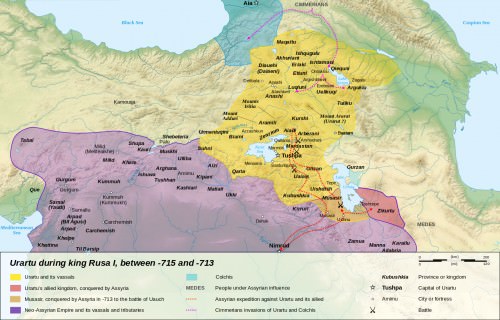
Urartu 714-715 BCE
With Urartu defeated, and fearing that his troops would mutiny if he led them further into the mountains in pursuit, Sargon II turned his forces around and headed back toward Assyria. He paused at the city of Mushashir, however, sacked it, and plundered the holy temple of Haldi, carrying off literally tons of gold, silver, and precious gems.
CONCLUSION
Sargon writes that, when King Rusas heard of the sack of Mushashir, “The splendor of Assur overwhelmed him and with his own iron dagger he stabbed himself through the heart, like a pig, and ended his own life.” The Urartians were defeated, and in less than six months of campaign, and so Sargon II returned to his capital of Kalhu at the head of his army in glory, carrying with him the immense wealth of Mushashir.
The difficulty of the Urartu campaign is made clear through Sargon II's letter to Ashur, but the obstacles did not deter the king from pursuing his objective. Even when his men refused to fight, Sargon II would not consider surrender or retreat. He took the risk of personally leading those who would follow him into battle, and he won.
In his letter to his god, Sargon details the difficulties he had to face in attaining his goal but he never hints at giving up. His perseverance and courage against all odds illustrates the truth of the sentiments expressed in Walter D. Wintle's poem, Thinking (from which the famous quote attributed to Henry Ford may have originated – even though Ford may never have actually said it): “If you think you can – or think you can't – you're right.”
Sargon II's resolve provides an example worth following for those in the present day who, faced with their own dark times, can still choose to fight against the forces which threaten them – and prevail.
LICENSE:
Article based on information obtained from these sources:with permission from the Website Ancient History Encyclopedia
Content is available under License Creative Commons: Attribution-NonCommercial-ShareAlike 3.0 Unported. CC-BY-NC-SA License